This soft and light Pita Bread is made from whole wheat flour and also has the trademark pita pocket perfect for stuffing with tahini, Hummus, Falafel or anything else you’d like! One of the easiest breads to make, it is also versatile and can be used for so much more than a pocket to put yummy things in. You can toast it to make pita chips or even use it flat to make a quick and easy pita pizza.
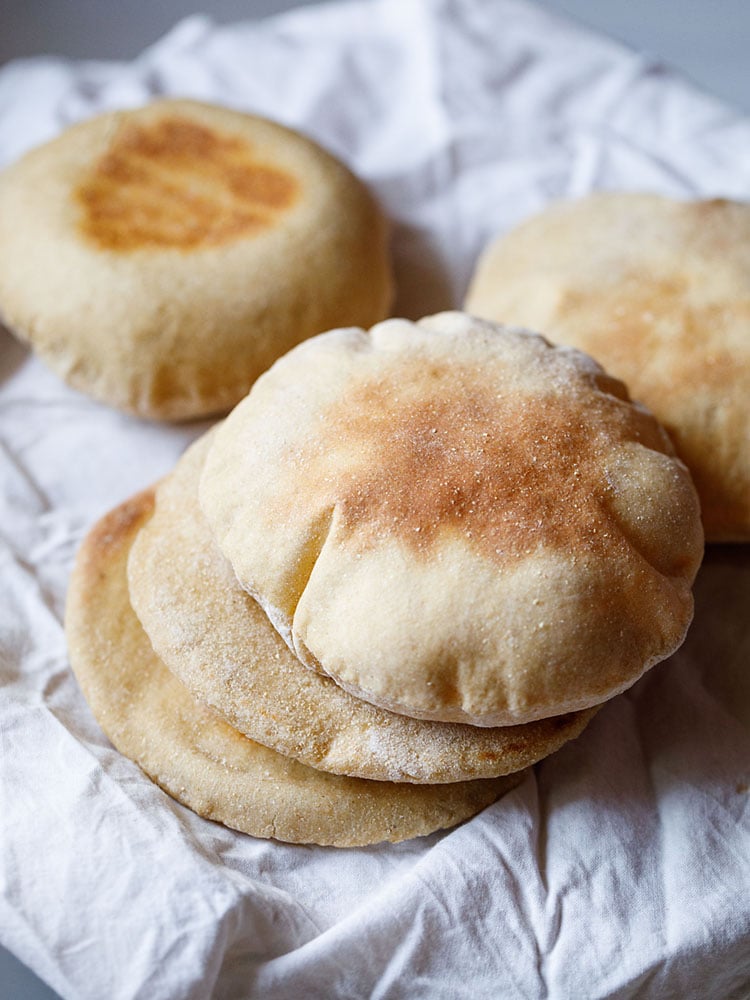
About This Pita Bread Recipe
Pita bread is a middle eastern flat bread that puffs up when baked creating an air pocket in the middle. As it cools, it deflates and flattens, but the pocket remains. Then, when you cut it in half, each half has its own pocket.
The first time I made pita bread was on the stovetop and I was so thrilled seeing the bread puffing up. Then later I started making pita bread in the oven and found that this caused it to puff up even further.
The oven baking method also works better because it prevents the bread from getting too browned as it does when making it on a skillet or frying pan.
However, I do allow it to get slightly browned in the oven as well because I prefer my bread well baked.
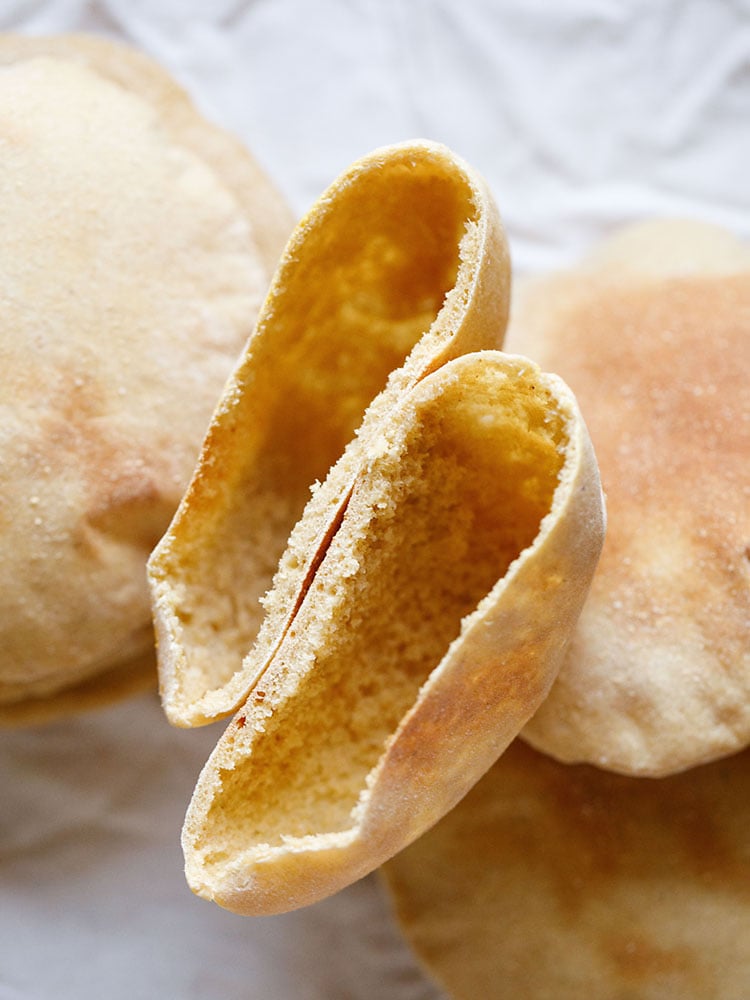
This pita bread recipe is adapted from one of my favorite bread books “The Bread Bible: 300 Favorite Recipes”, by Beth Hensperger. I can tell you from plenty of experience that this is the best recipe for making pita bread.
Once you have baked your homemade pita you can get creative and come up with different sandwich combinations and fillings.
Falafel is always a classic filling, but you really can put anything you like into it. Any type of mixed salad and dressing works well as the pita allows the taste of the salad to come through while making the meal more filling.
For a more authentic Indian or Middle Eastern experience, stuff your pita bread with some spiced sautéed veggies or potatoes or a dry Chana Masala.
Add some onion rings, tomato slices and mint chutney plus tamarind chutney. Or make some Veg Kebab or fried Vegetable Cutlet and add some classic Indian chutneys. So many options!
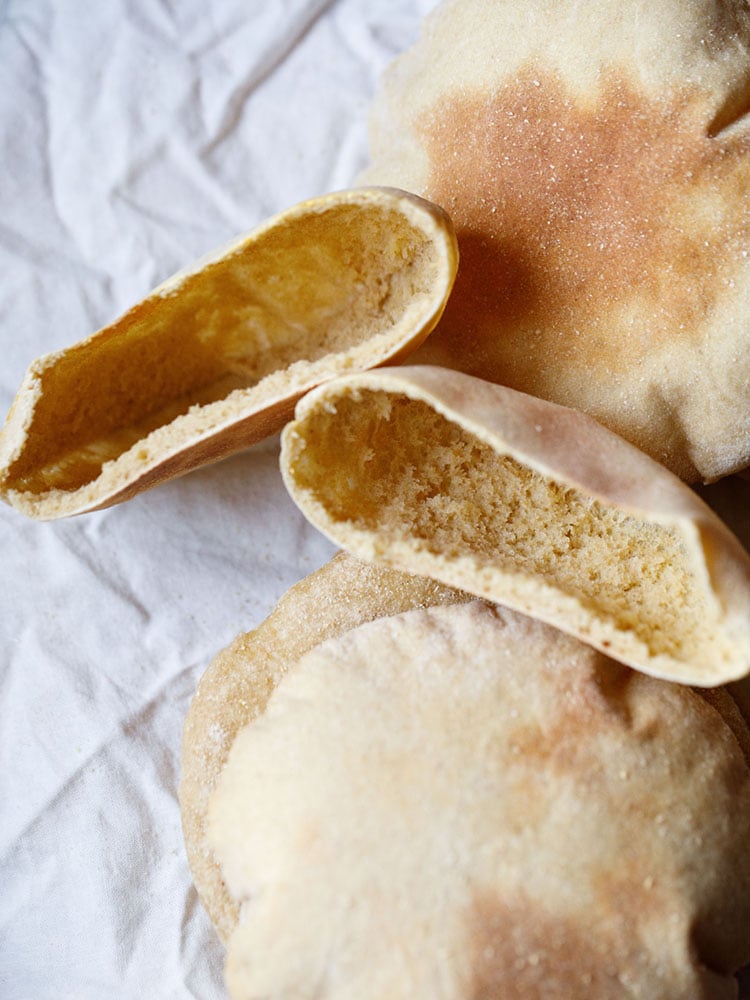
I have divided the step by step pictorial of pita bread recipe into 4 parts:
- Making the pita dough
- Assembling, shaping and rolling dough
- Baking pita bread in the oven
- Making pita bread on a skillet (stovetop method)
How to make Pita Bread Recipe
1: Making Pita Dough
1. Firstly take 1 teaspoon instant yeast and 1 pinch sugar in a stand mixer bowl or in any bowl in which you will knead the dough.
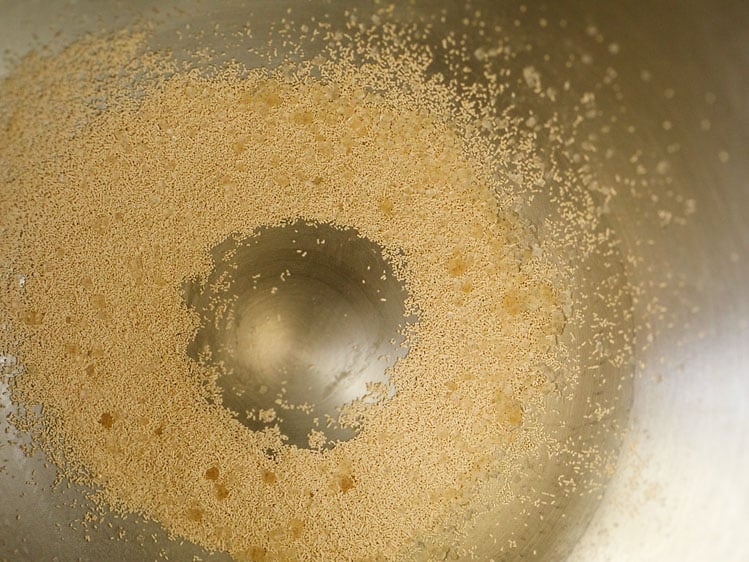
2. Pour 1 to 1.25 cups water and mix very well with a spoon. Depending on the quality of flour, you may add 1 to 1.25 cups water. Slightly coarse and grainy wheat flour will need 1.25 cups water.
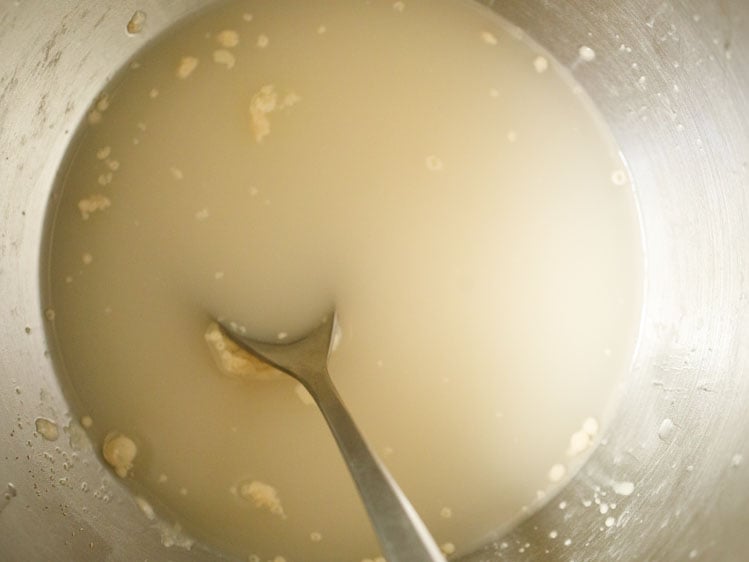
3. Add 3 cups whole wheat flour, 2 tablespoons extra virgin olive oil and 1 teaspoon salt.
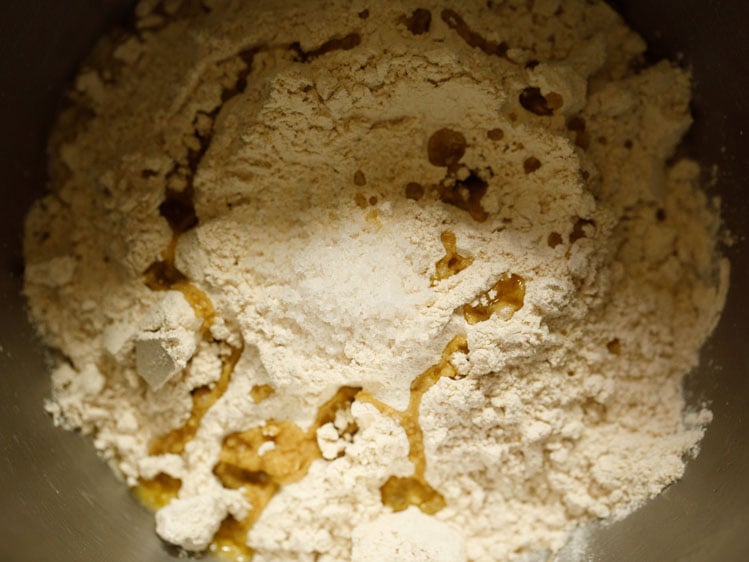
4. Mix everything with wooden spoon.
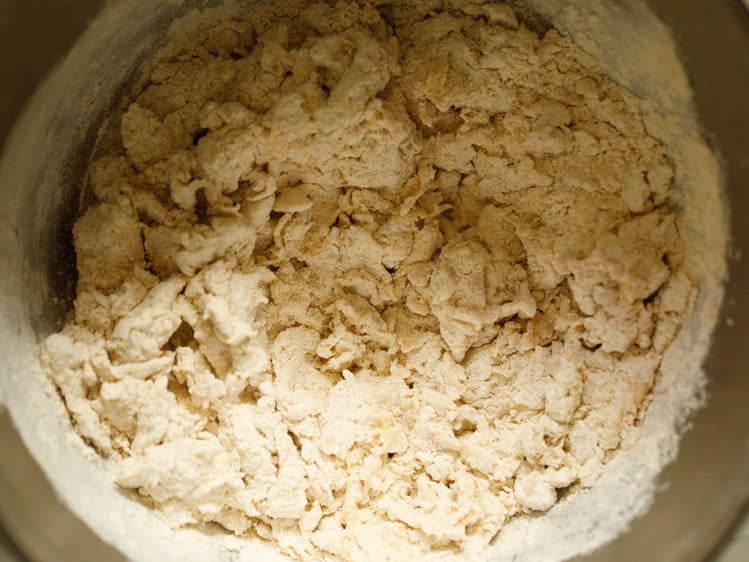
5. Then using the hook attachment begin to knead.
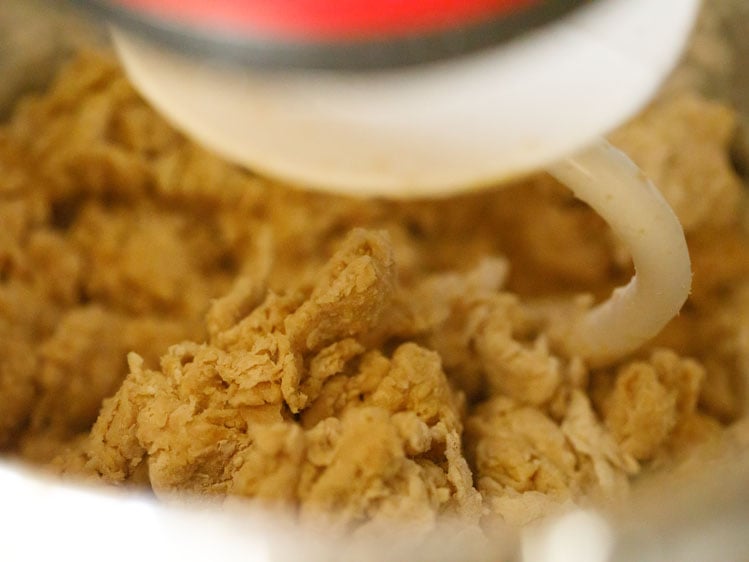
6. Initially, you will find the dough sticky, but continue to knead and you will see the extra water will be absorbed by the flour and stickiness will go away. If the dough looks very sticky even after kneading well, then add 3 to 4 tablespoons whole wheat flour. Mix and knead till smooth.
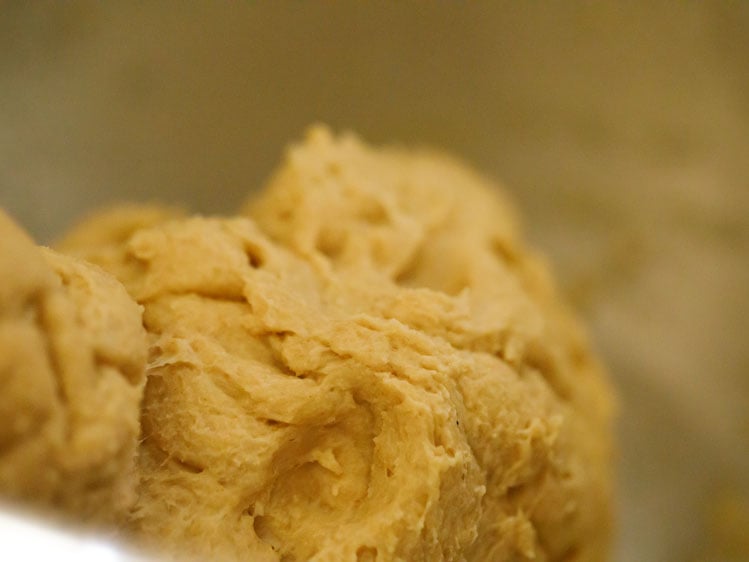
7. Knead to a smooth and soft dough.
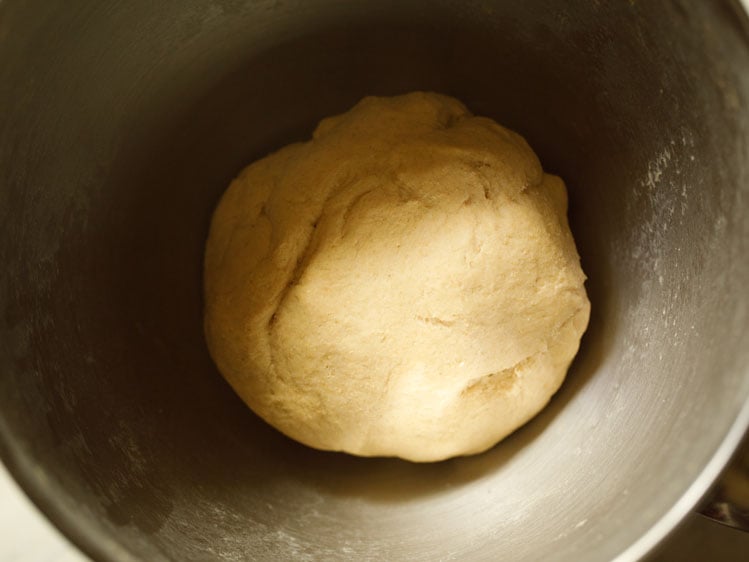
8. Rub or brush some water or olive oil all over the dough.
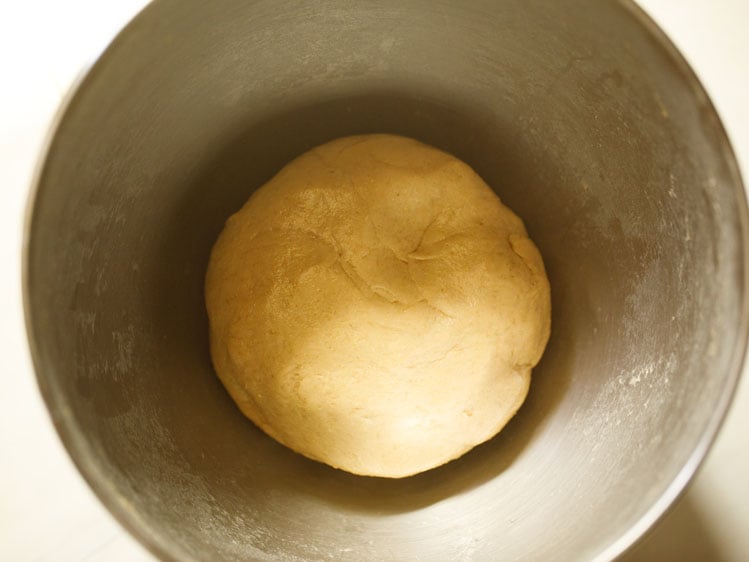
9. Keep it in the same bowl covered loosely with a kitchen towel for 45 minutes or 1 hour until the dough has doubled in volume and size.
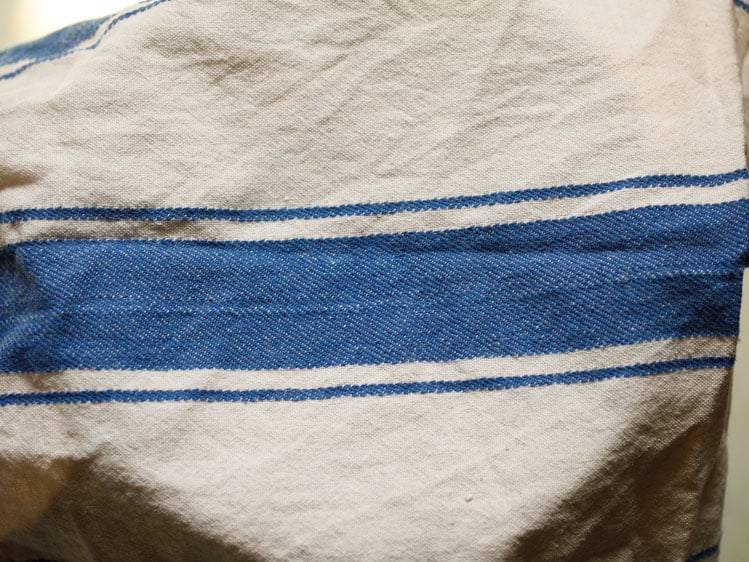
10. This is the photo of the dough after 1 hour.
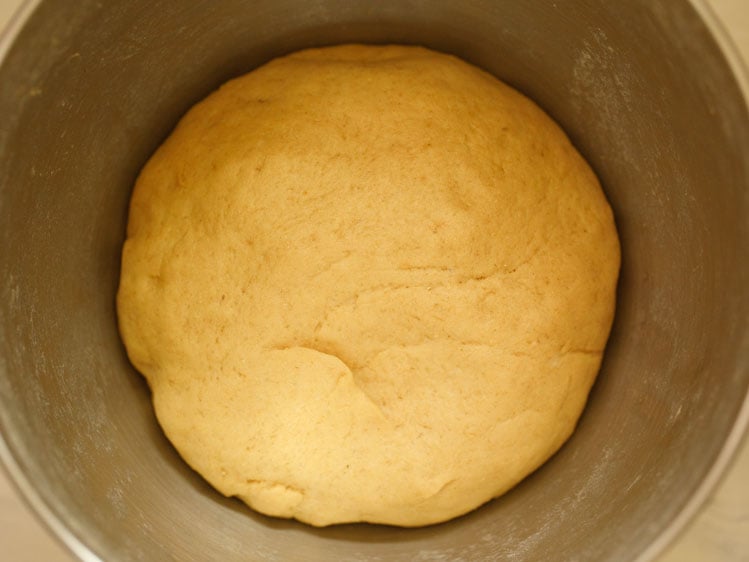
11. Deflate the dough gently and knead lightly.
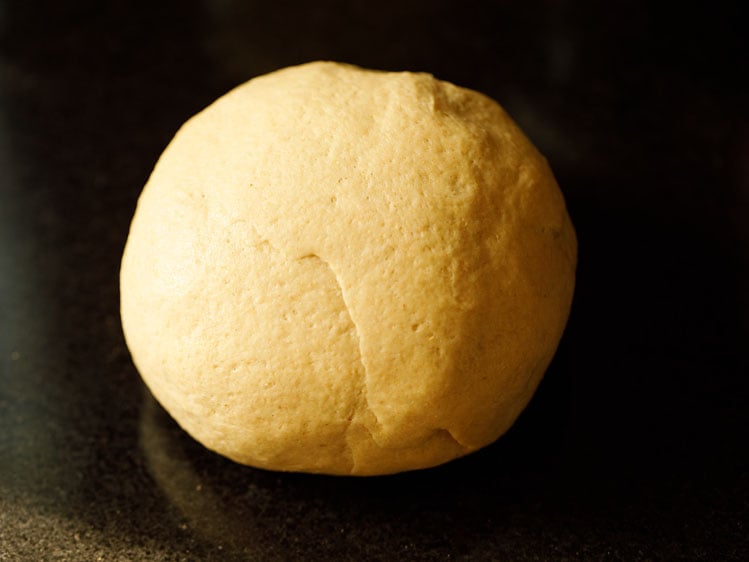
2. Assembling, shaping and rolling dough
12. Make into a log shape and cut equal portions from the dough. Keep these covered again for 10 minutes. Keep the dough balls covered all the time so that they don’t dry out.
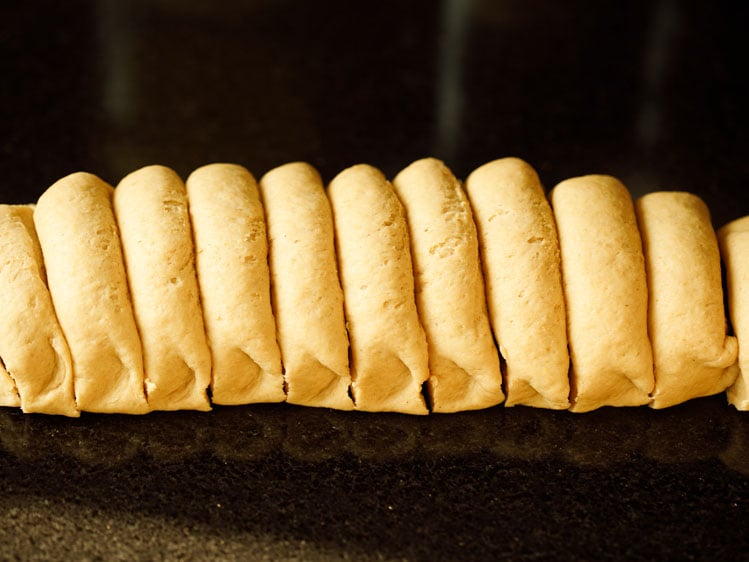
13. Meanwhile, place a baking tray in the oven. Then preheat oven at 230 degrees Celsius (446 degrees Fahrenheit) for 20 minutes.
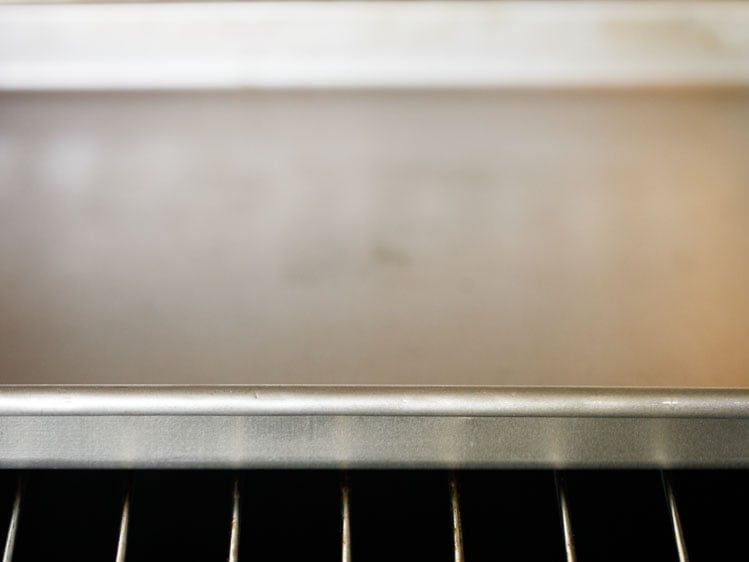
14. Take each dough portion and shape into a ball. Keep it on the work surface and sprinkle some flour on it as well as on the dough ball.
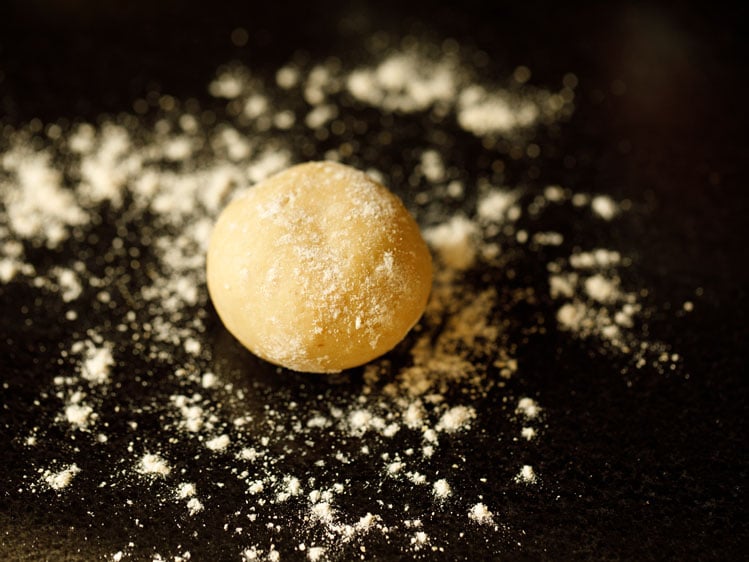
15. Roll evenly into a 5 or 6 inches round shape. You can also make them oval shaped if you want. For puffing it is very important to roll evenly. So do dust with slightly more flour. When you roll the dough with the rolling pin, the bread disc should also move clockwise while rolling.
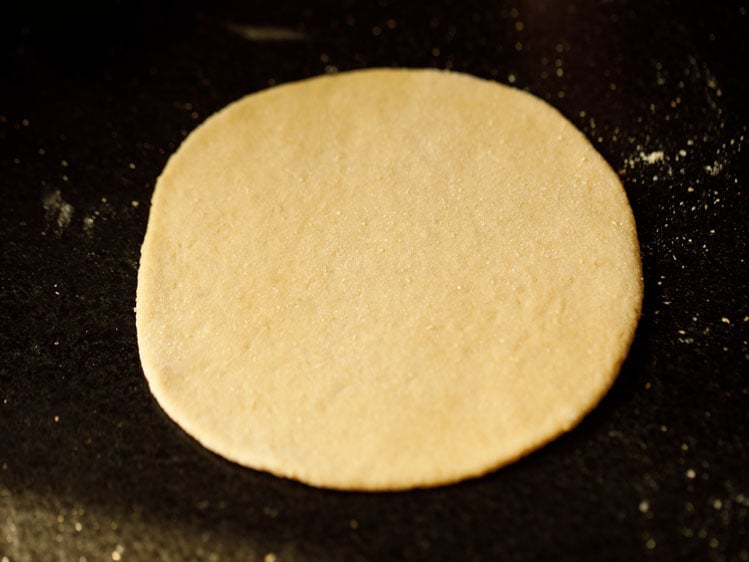
16. Keep the bread a little thick while rolling.
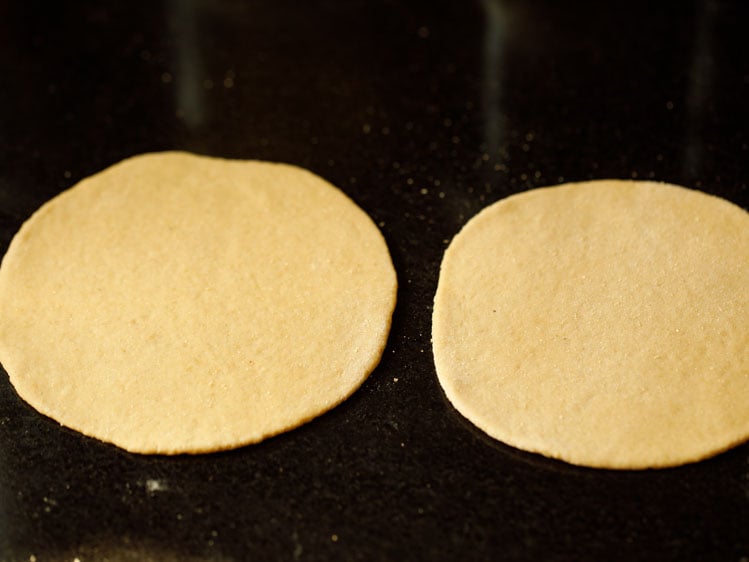
17. Keep these rolled discs covered loosely for 10 minutes.
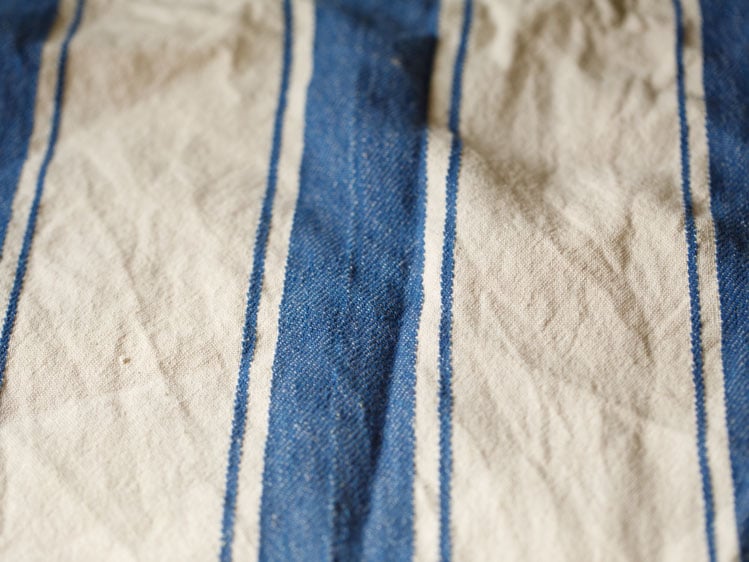
3. Baking pita bread in the oven
18. Carefully remove the baking tray from the oven with oven mittens. Sprinkle some flour and place the rolled discs in the tray. Use oven mittens when removing and placing the baking tray from the oven.
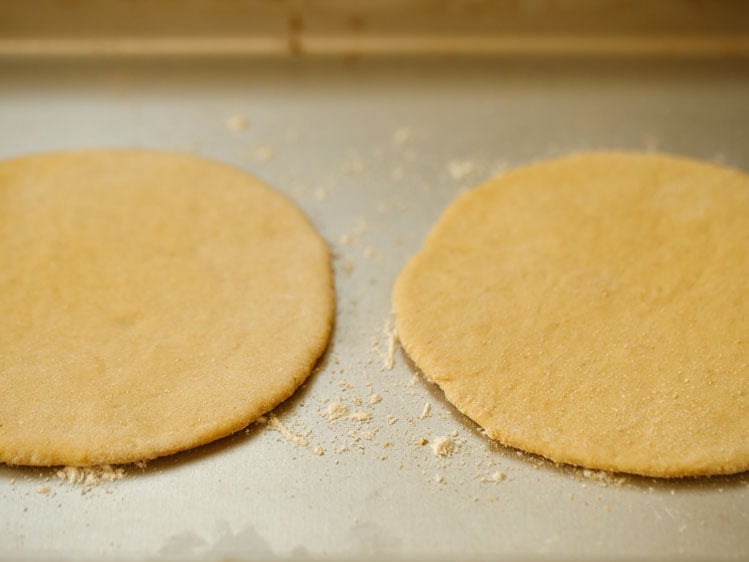
19. Place the tray back in the oven. Bake at 230 degrees C for 7 to 10 minutes. Mine took 7 minutes to cook and 1 minute to brown. Heat both the top and bottom heating rods of the oven.
If using a convection oven, then preheat as well as bake at 200 or 210 degrees Celsius (392 to 410 degrees Fahrenheit). Note that the baking time will vary from oven to oven. Look at those puffed up pita bread. Don’t they look good?
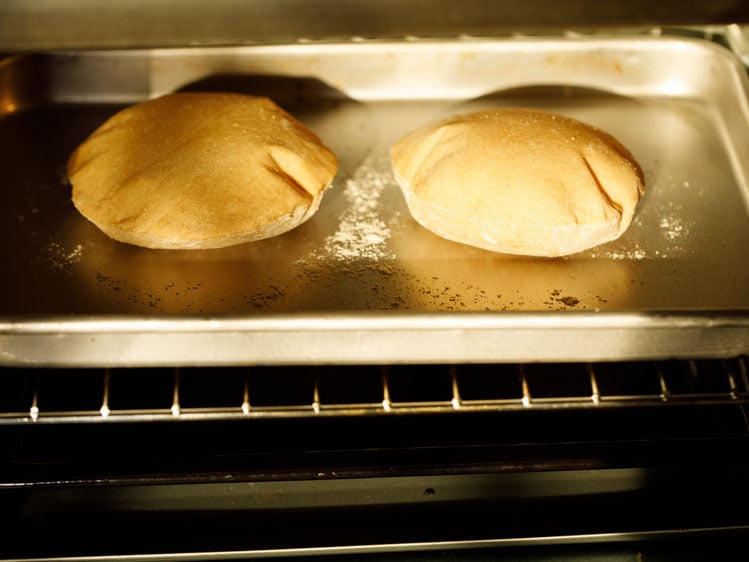
20. The pita bread will nicely puff up in the oven. Once they are puffed up and have a pale golden color, remove the tray. With a spatula remove the pita bread and place on a wired rack.
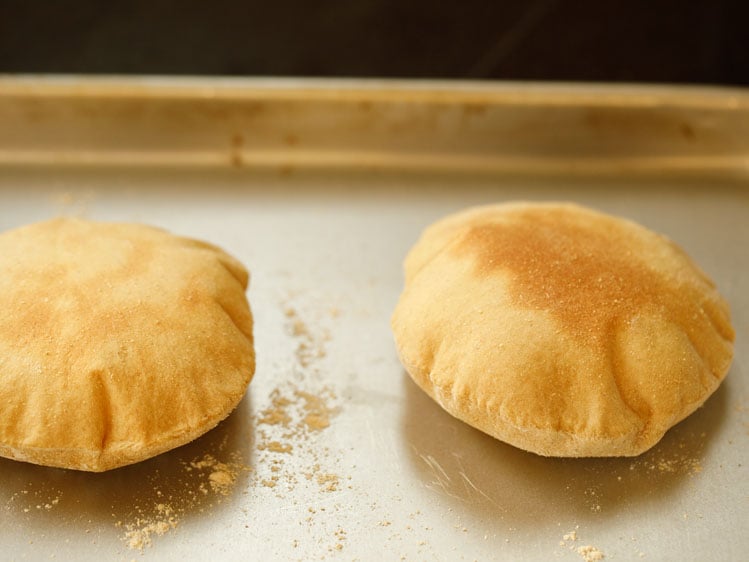
4: making pita bread on a skillet (stove-top method)
21. Heat a cast iron skillet or a frying pan on medium-high flame. Sprinkle some flour on the pan and it should get browned. This means that the pan is hot.
Use a heavy pan so that the pita bread does not get burnt from the bottom. Place the pita bread dough disc on the pan or skillet.
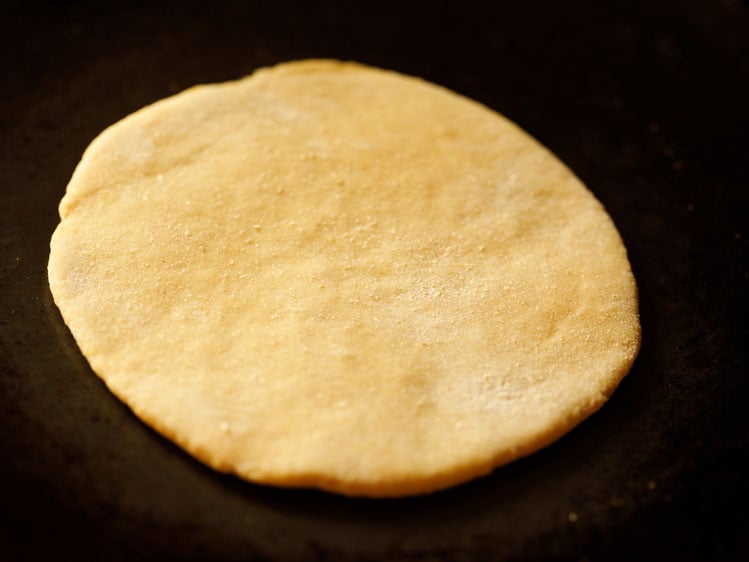
22. As soon as you keep the dough round on the pan you will see it getting puffed up.
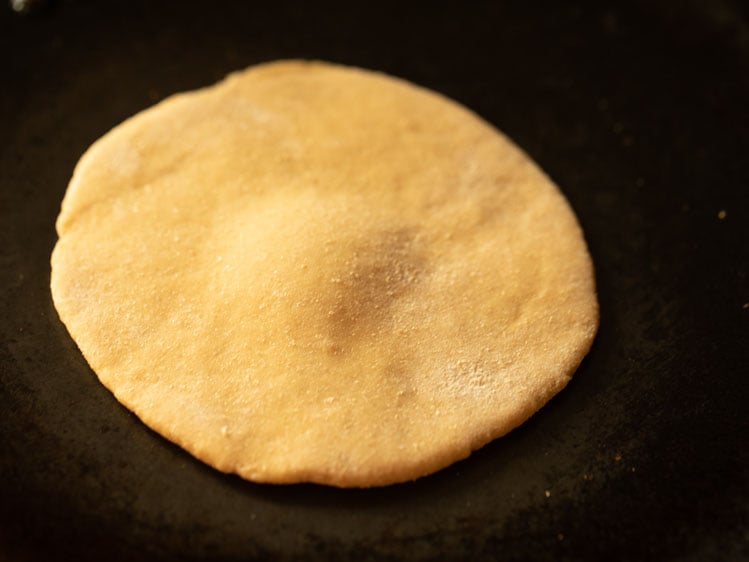
23. Cover with lid for 1 to 2 minutes.
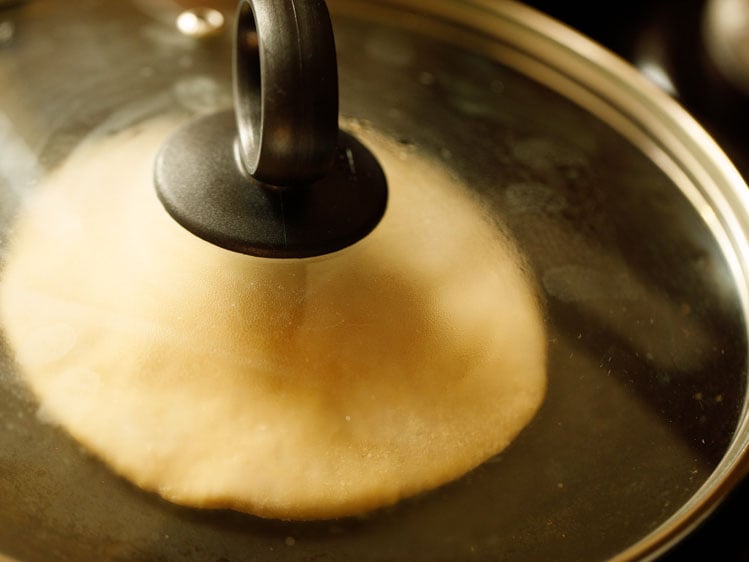
24. Here is the pita bread nicely puffed up.
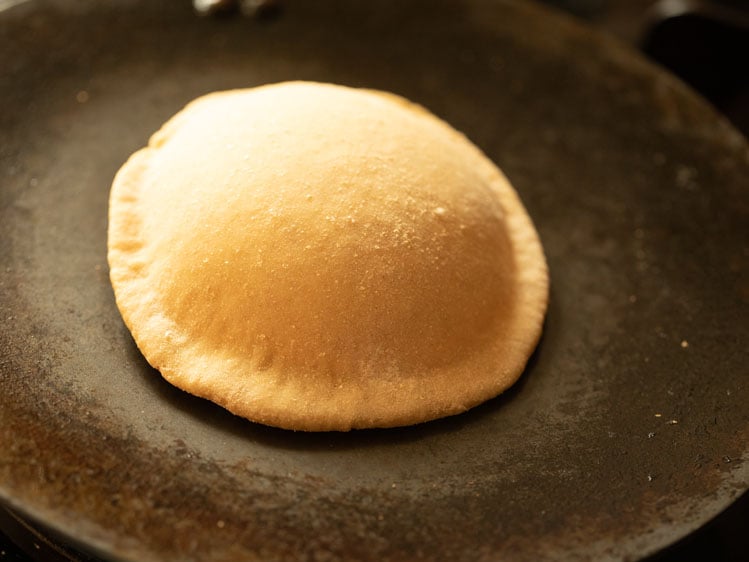
25. Turn over and cook for 1 to 2 minutes more till the pita bread is done and has brown spots appearing on both sides. Roast all pita breads this way. Alternatively, you could also make them the way we make Indian Flatbread – Roti (Phulka). After lightly cooking both sides on the skillet, place them on the fire and see them puff. Cook both sides.
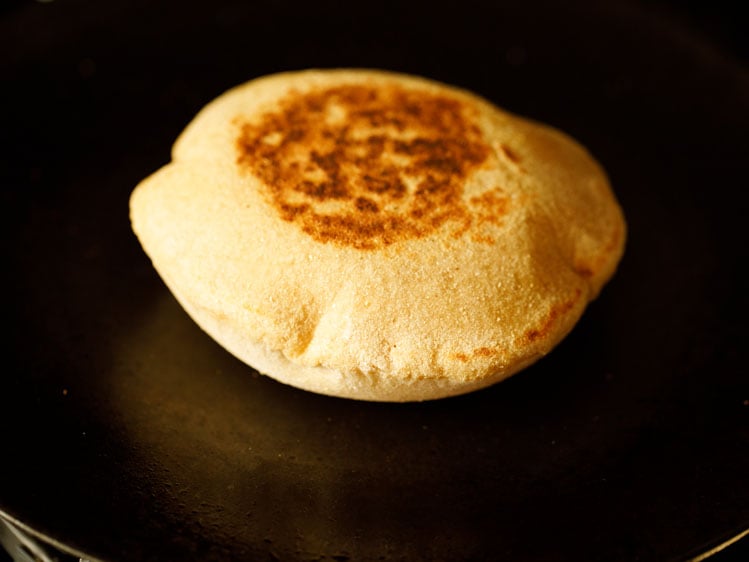
26. Stack pita bread and store them in a kitchen towel or bread box. Slice the pita bread into two and you will see the pockets.
Stuff the pockets with a filling of your choice and your pita sandwich is ready. You can make pita sandwiches with falafel, hummus, tahini and pickles or salad.
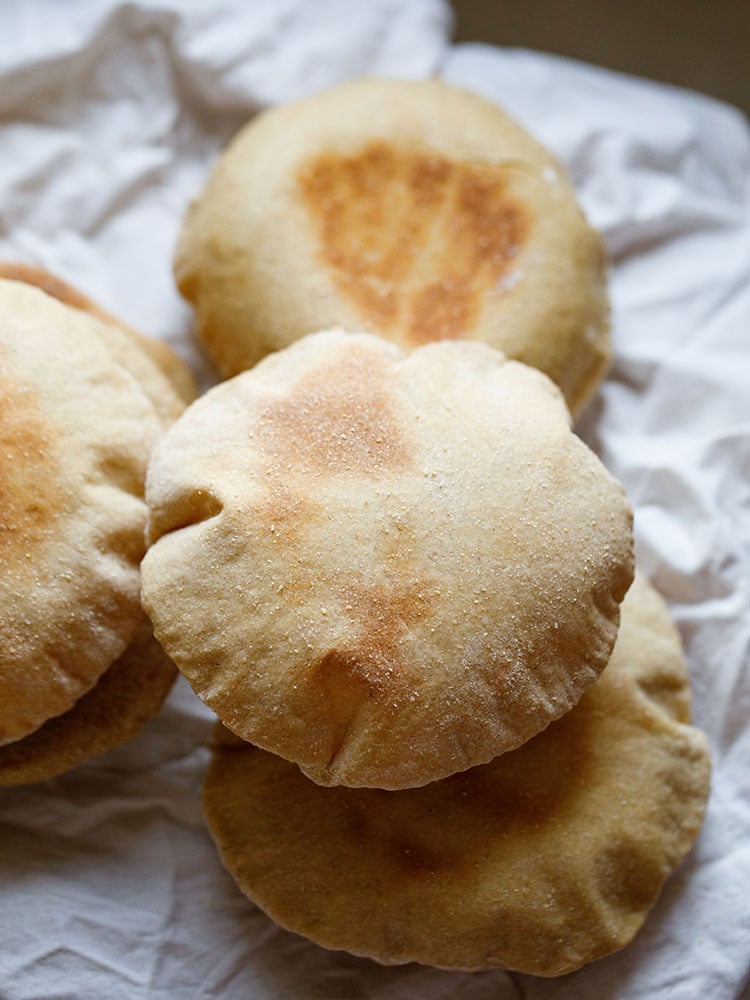
FAQs
I have listed some queries that readers have asked on this recipe post and my answers to them.
- Why my pita bread has no pockets?
There are a few things that if done correctly will puff the pita bread resulting in the pockets.- Water Content: The dough needs to have the perfect amount of water in it. Less percentage of water will make the dough hard or denser in texture and the pita bread won’t puff up.
- Texture of the Dough: The dough has to be kneaded really well. It should be soft and smooth.
- Rolling: If the dough is not rolled evenly, then the pita bread won’t puff. So there won’t be the pockets.
- Oven Temperature: The oven has to be very hot. Sometimes the oven isn’t actually reaching the temperature that it is set at. Then you will need to calibrate the oven. If the oven isn’t thoroughly preheated or hot enough then this cause the pita bread to stay flat and not puff leading to a denser bread.
- Why my pita bread is hard?
If you use dry active yeast then you need to activate it and proof it. If the activation and proofing are not done well, the dough won’t leaven resulting in hard bread. While activating, the water has to be lukewarm and not hot or cool. Note for instant yeast, you don’t need to proof or activate it and can use room temperature water - Can this recipe be halved or doubled?
Yes, you can easily scale the recipe. - Can I add all-purpose flour in the recipe?
Yes. But add about 1 cup of water while kneading. - Can we add milk instead of water?
Yes, you can add milk. You can use the same amount of milk as that of water – 1 to 1.25 cups. However, do note that depending on the quality of flour you may need to add less or more milk. - Can I add a combination of water and milk?
Yes you can do that - Can I add some yogurt (curd)?
Yes, you can add some yogurt in the dough and it will help in making the bread soft as well as give it a faint sour taste. - Why do some parts of the dough rise and some do not?
It is because the dough is not rolled evenly. Some parts will be thick and some parts will be thin resulting in an uneven thickness which makes the dough partially puff up at some spots. - Can we skip yeast and use baking soda?
You can but you will need to experiment with the recipe. - Can you freeze this homemade pita dough?
Yes, you can. - Can you freeze pita bread?
Absolutely! Freeze them in ziplock bags or in boxes. These stay good for months. - Can I use fresh yeast instead of instant yeast and in what quantity?
You can add 1 tablespoon fresh yeast. Note that you will need to activate and proof fresh yeast like dry active yeast. - Can I make the dough at night and leave it for leavening in the fridge ?
The dough has to be leavened outside at room temperature. Once the dough is doubled, then you can refrigerate it. - How to store pita bread?
Place them in a steel box or ziplock bags. Then you can either refrigerate or freeze the pita bread. - How to warm pita bread?
Heat a skillet or pan. Place the pita bread and cook it for 10 to 12 seconds on medium-heat till lightly hot on both sides.
Few More Bread Recipes
Please be sure to rate the recipe in the recipe card or leave a comment below if you have made it. For more vegetarian inspirations, Sign Up for my emails or follow me on Instagram, Youtube, Facebook, Pinterest or Twitter.
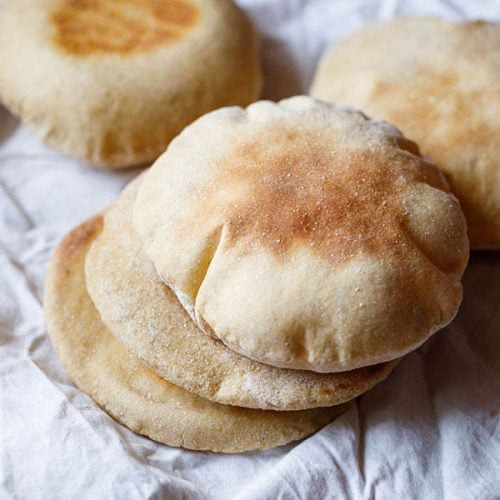
Pita Bread Recipe (Oven & Stovetop)
Ingredients
- 1 teaspoon instant yeast or 1.5 teaspoon dry active yeast (for dry active yeast check the notes below on activating and proofing it)
- 1 pinch raw sugar or white sugar
- 1 to 1.25 cups water or add as required
- 3 cups or 360 grams whole wheat flour
- 2 tablespoons extra virgin olive oil
- 1 teaspoon salt
Instructions
Preparing dough
- Firstly take the instant yeast and sugar in a stand mixer bowl or in any bowl in which you will knead the dough. Pour 1 to 1.25 cups water and mix very well with a spoon.
- Add 3 cups whole wheat flour, 2 tablespoons extra virgin olive oil and 1 teaspoon salt. Mix everything with wooden spoon.
- Then using the hook attachment of the stand mixer and begin to knead. Initially you will find the dough sticky, but continue to knead and you will see the extra water will be absorbed by the flour. Knead to a smooth and soft dough.
- Rub or brush some water or olive oil all over the dough. Keep it in the same bowl covered loosely with a kitchen towel for 45 minutes or 1 hour until the dough has doubled in volume and size.
Assembling, shaping and rolling dough
- Deflate the dough gently and knead lightly. Make into a log shape and cut equal portions from the dough. Keep these covered again for 10 minutes. Keep the dough balls covered all the time so that they don't dry out. You can even pinch portions from the dough and roll them into balls.
- Meanwhile place a baking tray in the oven. Then preheat oven at 230 degrees celsius for 20 minutes.
- Take each dough portion and shape into a ball. Keep it on the work surface and sprinkle some flour on it as well as on the dough ball. Roll evenly into a 5 or 6 inches round shape. You can also make them oval shaped if you want. Keep the bread a little thick while rolling.
- Keep these rolled discs covered loosely for 10 minutes more.
Oven method to make pita bread
- Carefully remove the tray with oven mittens. Sprinkle some flour and place the rolled discs on it. Use oven mittens when removing and placing the baking tray from the oven.
- Using oven mittens, place the tray back in the oven. Bake at 230 degrees C for 7 to 10 minutes. If using a convection oven, then preheat as well as bake at 200 or 210 degrees celsius. Note that the baking time will vary from oven to oven.
- The pita bread will nicely puff up in the oven. Once they are puffed up and have a pale golden color, remove the tray. With a spatula remove the pita bread and place on a wired rack.
Stovetop method to make pita bread
- Heat a cast iron skillet or a frying pan on medium-high flame. Sprinkle some flour on the pan and it should get browned. This means that the pan is hot. Use a heavy pan so that the pita bread does not burnt from the bottom. Place the pita bread round on the pan or skillet.
- Cover with lid for 1 to 2 minutes.
- Turn over and cook for 1 to 2 minutes more till the pita bread is done and has brown spots appearing on both sides. Roast all pita breads this way. Alternatively, you could also make them the way we make Indian Flatbread – Chapati (Phulka). After lightly cooking both sides, place them on the fire and see them puff. Cook both sides.
- Stack pita bread and store them in a kitchen towel or bread box. Just slice the pita bread into two. You will see the pockets. Stuff the pockets with a filling of your choice and your pita sandwich is ready.
Video
Notes
- Pita Bread Dough: The dough needs to have the perfect amount of water in it. Less percentage of water will make the dough hard or denser in texture and the pita bread won’t puff up. Depending on the quality and type of flour used, you can add less or more water. The dough has to be kneaded really well. It should be soft and smooth.
- Kneading with hands: The pita bread dough can be easily kneaded with hands. Knead the dough very well for about 10 to 12 minutes.
- Rolling the dough discs: If the dough is not rolled evenly, then the pita bread won’t puff. So there won’t be the pockets or you may have the pita bread puffing on some spots and remaining flat on others.
- Oven Heating: The oven has to be very hot. Sometimes the oven isn’t actually reaching the temperature that it is set at. Then you will need to calibrate the oven. If the oven isn’t thoroughly preheated or hot enough then this cause the pita bread to stay flat and not puff.
- Using dry active yeast: If you use dry active yeast then you need to activate it and proof it. If the activation and proofing is not done well, the dough won’t leaven resulting in hard bread. While activating, the water has to be lukewarm and not hot or cool. Note for instant yeast, you don’t need to proof or activate it and can use room temperature water
- Scaling: You can easily halve or double the recipe.
- Storing Pita Bread: Place them in a steel box or ziplock bags. Then you can either refrigerate or freeze the pita bread.
- Reheating: To warm or reheat pita bread, heat a skillet or pan. Place the pita bread and cook it for 10 to 12 seconds on medium-heat till lightly hot on both sides.
- Substitutes:
- Whole wheat flour: Replace with all purpose flour.
- Water: Can be replaced with milk (dairy or vegan).
- Instant yeast: You can use 2 teaspoons of dry active yeast and 1 tablespoon fresh yeast instead. Both these yeast will need to be activated in lukewarm water with sugar before adding to the flour.
Nutrition Info (Approximate Values)
This Pita Bread recipe from the archives was first published on July 2012. It has been updated on November 2024.
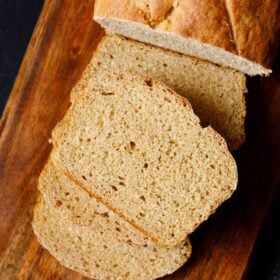
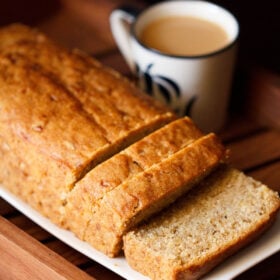
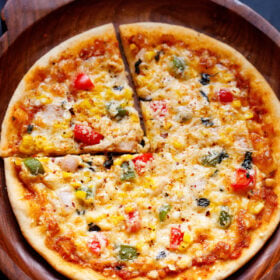
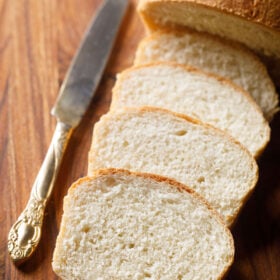








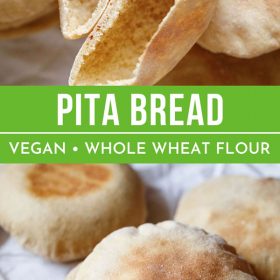
Wow, this is so amazing! Very impressive. I wish I were good at making this. But I am going to give it a serious shot.
do give it a serious shot asmita. pita bread is one of the easiest bread to make.
Hi Dassana
I have a request to you that if can provide me the recipes without onion & garlic also because we don’t eat onion & garlic. But you can send me some with onion & garlic too, i will take off onion & garlic from it and make it.
Thanks
dear katha, i have a lot of no onion and garlic recipes on the blog. here is the link:
https://www.vegrecipesofindia.com/recipes/no-onion-no-garlic-recipes/
for the rest of the recipes you can browse through the indian platter section on the right hand side bar. you can easily make them without onion & garlic.
two links for you of dal-curries and sabzi recipes. adapt these without onion and garlic.
https://www.vegrecipesofindia.com/recipes/dal-recipes-indian-curries/
https://www.vegrecipesofindia.com/recipes/indian-vegetable-recipes/
Thank you so much for the love and care you put into your blog. I have been absent from visiting for a while. I have some enjoyable reading to catch up on your posts. I am planning on making your Pita bread tomorrow. Best wishes.
thanks lydia for your beautiful comments. do read the posts when you get time.
Lovely photos and step by step instructions. I love pita and like that this is whole wheat too!
thanks shumaila.
superb pics,mouthwatering….sure going to try.
loved the daintily puffed beauties- good one !
Such beautiful pictures! Pita looks perfect!
These pita pockets are perfectly baked!
I tried it earlier and it did not puff this much and that was a disappointment since I had excellent falafel to go along with it. Will make it this way… thanks for the step by step method
Amazingly puffed up pita breads, dassana! I love how well the pockets have formed!! I’ve made stovetop and oven pitas but have never tried firing them directly on the flame like a phulka. Definitely gonna try that next time. Thanks for sharing. 🙂
thanks susmitha.
Hey dassana, I wanted to let you know that thanks to you, I made beautiful, puffy pitas yesterday! 🙂 I used a mix of whole wheat, maida, bajra and besan flours. Other than that, I stuck to your recipe completely. I also noticed from your photos that when you say oven, you’ve used a microwave. I normally don’t like to do my bread or cake baking in the micro, but I decided to try it out for the pitas since that’s what you’ve used and it did the trick to make them puff up beautifully!! 🙂 Yay!! afterwards, I lightly toasted a few on the direct flame like phulkas and that added an additional yumminess.
So from now on, I’ll be baking all my pitas in the microwave. 🙂 Thank you.
thanks susmitha. you have even made such a healthy version of the pita bread.
i do use microwave oven but mostly for baking. i bake in the convection mode in the oven. i don’t use the microwave mode for baking. is there anything wrong in baking in convection mode…. may be i don’t know.
Hi dassana, I wasn’t trying to make it healthy, I had very little wheat flour at home so had to add maida and I felt so guilty to add so much Maida that I decided to compensate by adding Bajra and besan. Hahaha It was totally experimental. :p
Even I used the convection mode in my micro for the pitas, because the bread won’t come out well in the microwave mode. Normally though, the reason I prefer a regular oven to the convection mode of the microwave oven for breads and cakes is because they come out much better in texture in a regular oven. It might be because of the fan in the microwave or because there are always some waves present even in convection mode, but for whatever reason, the baked goods made in a microwave’s convection mode don’t retain moisture well.
But in the case of your pita recipe, that worked to my advantage and the pits puffed up. 🙂 I think those people who have tried this recipe and said their pits didn’t come out as perfect as yours must have used a regular oven. Maybe you can suggest the convection mode of the microwave to them and see if that makes a difference.
Ahhh so sorry for all the spelling mistakes. My iPad did auto correct and messed everything up!
I meant maida and bajra in the first paragraph.
i have corrected your comment with the correct spellings. i do get comments with incorrect spelling. if i am able to spot them, i correct them.
thanks susmitha for the detailed reply. i really appreciate this gesture.
i bake everything in the microwave because i don’t have a regular oven. the only problem i face while baking is quick browning. so i cover the cakes or breads with a butter paper or aluminium foil. otherwise texture wise i have not had any problem. even moisture wise, the breads which i make are moist. they are not dry. i bake a lot of breads at home. just that i don’t take pics and post about them…. i am lazy 😉
the original recipe uses the regular oven. plus the only change i made is making the pitas with 100% whole wheat keeping the rest of the ingredients same. in the original recipe maida and whole wheat flour proportion is half-half (i also don’t like maida like you). so i think the breads should come out well in a regular oven. my readers who tried and it did not come out well may be due to the yeast proofing not done well – which is the most important factor to make good yeasty breads and loaves. i will mention a point though about convection baking in microwave in the post.
dassana, so my falafels came out well yday and next is the pita bread and i am going to follow ur recipe.. BTW, the custardwe get in india( have a light coclour.. i usedto use brown and polson there….
here teh powder we get is alight pink coclour but as soon as it is mixed witha liquid,it gets a deep yellow colour.. i used a brand called daily fresh..the custard jam drops i have posted were also from same custard and they also turned more yellow than they had when i had made them in india..
thanks renu for the info on custard powder. i must say that the color of the custard pudding looks very good.
This is just cool! the way it looked like balloon is ecstatic..haha. 🙂 I love to try it.
thanks leona.
Thanks for sharing the recipe – they look sooo good!
welcome jenny
Dear Dassana, yesterday we had lebanese food and the pita bread looks ditto as in the pics as we had over there..and that is known to be as the one of the best restaurant in Dubai for lebanese food… i am now inspired to make them at home…wonderful work by you:)..
Request…Pls post kesar Ras malai receipe… I have tried couple of times from different blogs (showmethecurry, vahchef, manjulas kitchen) but it did not come out spongy and porous like available in the good sweet shops… in some youtube video they said that professionals add baking/ soda to make it porous and spongy but didnt mention when to add and how much to add…
with love, meeta…
hi meeta, i approved your comment but was going to reply later and then eventually forgot.
in fact yesterday after reading your comment, i decided to make rasmalai as it is hubby’s favorite too. i made the chenna yesterday and today i was going to make rasmalai, but it is too dark here with very heavy rains.. so photographs won’t come good. so hope to make them later and will post too.
also thanks for all your positive comments. do try the pita breads at home. you won’t miss the restaurant ones 🙂
thank you dear… i will definately going to try…u knw u r my confidence… whenever i am stuck with any receipe, i kwn i will get the answer / guidance from u…lots n lots of love to you…
thanks for your lovely words meeta. but to tell you a fact – i am not very good at making traditional indian sweets. hence i don’t post them. i just saw vahchef’s & manjula aunty’s videos. also referred some books and they have added baking soda/powder to the chenna mixture. the chenna which i have made has not become soft. so i just hope that the rasmalai becomes soft.
hey meeta, i started making the rasmalai today only to meet up with a disaster. the chenna balls disintegrated in the sugar syrup 🙁
so i strained the cooked sweet chenna and will make sweet paneer parathas tomorrow 🙂
i have to find out the reason for this. i have made rasagullas before, but never ever this things has happened.
Did it happen!! it will be blessing in disguise now as you will put more effort to find out the reason and we will all be blessed for the perfect rasmalai receipe then:) You know my Pita bread turned out hard bread and my husband was laughing at me that it can break anybody’s head…i was overconfident seeing how you have done but may be lack of experience at my end..i also forgot to place napkin on the rolled pitas for ten minutes before putting them in the oven…even the oven i have, takes double time..it is provided by the builder…now i do not know where i went wrong?
i am actually planning to make the perfect rasmalai now 🙂
either the yeast did not proof up or must be an outdated yeast. also too much baking can make them hard. you could have made them on the tava instead. plus it is required that you keep them covered for 10 minutes.
Pita bread cant be any better..looks so perfect but can I try this in my OTG too??
thanks sharmilee and yes… you can make them in your OTG too. just bake them in a preheated oven at 200 or 250 degrees C for 5 to 10 minutes.